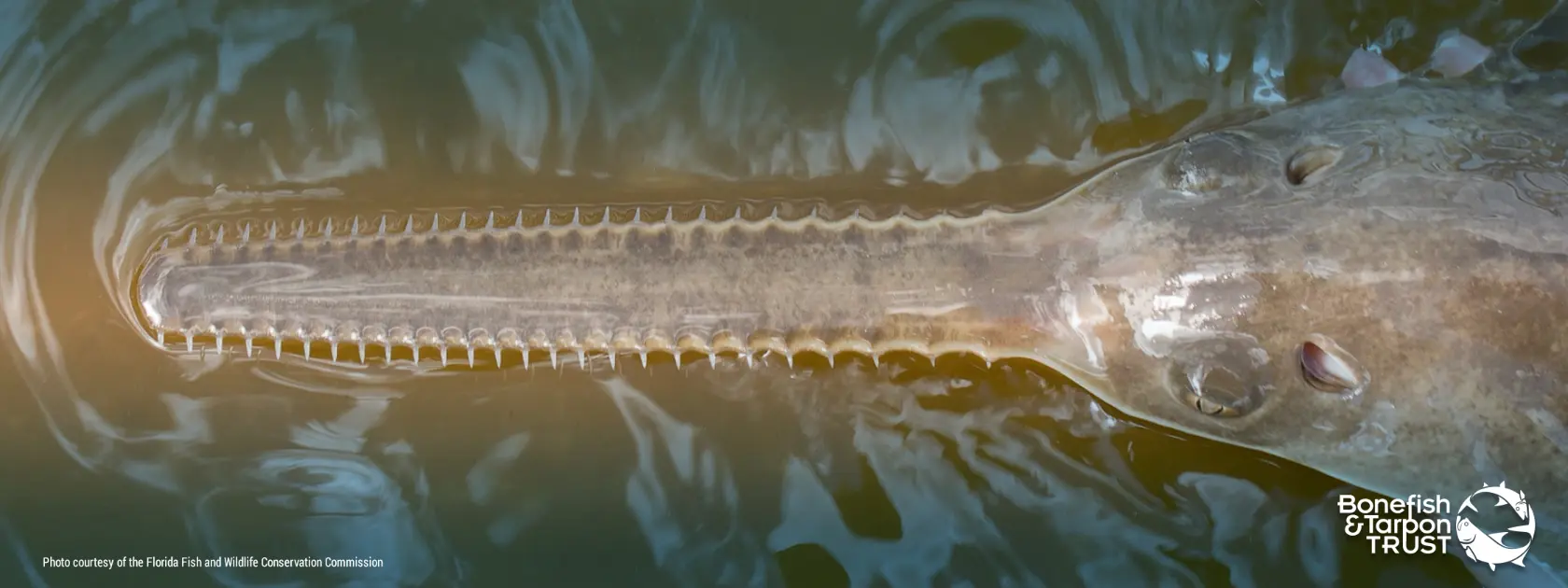
Bonefish & Tarpon Trust (BTT) and the Lower Keys Guides Association (LKGA) received the first report of fish in the Florida Keys exhibiting abnormal, spinning behavior in October 2023. Fish with the “spins” experience loss of equilibrium, causing them to swim upside down in repeated circles, often following a stressful or stimulating event.
Now, we continue working to determine the drivers of this event, monitor its potential spread, engage with local fishing guides and partners, and produce science-based recommendations to mitigate future impacts.
| Symptomatic Fish Reports (LKGA and BTT) | Species Affected | Areas Affected | Sawfish Mortalities | Samples Tested |
|---|---|---|---|---|
| 233 | 80 + species including: silver mullet, tarpon, permit, snook, bonefish, pinfish, bigeye scad, ballyhoo, jack crevalle, yellow jack, blue runner, southern stingray, mutton snapper, mangrove snapper, cubera snapper, lane snapper, leatherjacket, yellowfin mojarra, scaled sardine, toadfish, goliath grouper, blue striped grunt, redfish, lemon shark, Atlantic sharpnose shark, smalltooth sawfish, and spadefish. | Lower Keys Middle Keys Upper Keys Very few reports in offshore areas Very few reports outside the Florida Keys | 54 | More than 800. Hundreds of water, algae, and tissue samples continue to be run through dozens of laboratory tests. |
*Table updated October 11, 2024
A collaborative research study is underway to determine the cause of the spinning fish phenomenon. This inter-institutional research study, which began in January 2024, is funded by a $1.75 million grant from the State of Florida. Several organizations are involved in this effort, including:
BTT is working closely with over 85 local professional fishing guides and captains across the Florida Keys to track the spread and intensity of the spinning fish phenomena through a Rapid Response Network launched in April 2024. This allows BTT to track affected areas and target collections of fish and water samples from these new zones. Local fishing guides are supporting BTT by providing weekly status updates on water quality conditions and spinning fish reports to detect if a re-emergence of the phenomenon occurs in real time.
Benthic algal samples from the Lower Keys were shown by FGCU to have elevated concentrations of a dinoflagellate in the genus of Gambierdiscus occurring in areas where symptomatic fish are present. Gambierdiscus can produce multiple types of neurotoxins that can cause behavioral effects in fish. These toxins and others produced by other benthic dinoflagellate taxa are being targeted for further analysis by USA/DISL.
Ecotoxicology assessments by USA/DISL revealed that the pathway to neurotoxin exposure occurs through the gills, and accumulation of those toxins happens within the liver. And, less accumulation of toxins in the muscles of symptomatic fish and sawfish.
As predicted, rising water temperatures in the spring of 2024 saw a decline in reports of spinning fish. As temperatures decrease in the fall, BTT and partners continue to act proactively by:
We do not know. Reports of spinning fish declined in spring of 2024 with rising temperatures. Cooler temperatures could result in a resurgence.
There have been reports of spinning fish beyond the Florida Keys, however we do not know how it spreads. Reports of spinning fish and gambierdiscus samples have been observed to be highly localized.
Always consult with Florida Department of Health Fish Consumption Advisories: https://dchpexternalapps.doh.state.fl.us/fishadvisory/
Always consult with Florida Department of Health Swimming Advisories: https://monroe.floridahealth.gov/programs-and-services/environmental-health/beach-water-testing/index.html
According to the National Oceanic and Atmospheric Administration (NOAA), harmful algal blooms (HABs) occur when colonies of algae proliferate in the water column and produce toxins that may be harmful to humans, fish, marine mammals and/or birds. HABs can be planktonic (algae suspended in the water column) or benthic (algae attached to the bottom/other surfaces – like coral, sand and seagrasses).
This is an area that BTT is currently actively researching. Initial testing shows that some species of fish may recover from the spinning behavior after being placed in a different water source. However, testing remains ongoing to determine whether complete recovery has occurred.
Gambierdiscus is a type of microscopic algae known as a dinoflagellate. Dinoflagellates are a group of tiny single celled plankton found in marine and freshwater environments globally. In marine environments, over 1500 species of dinoflagellates have been described – this includes 18 species of Gambierdiscus. Gambierdiscus are a benthic species, meaning they are found attached to substrates like dead coral, sand, or attached to seagrasses and other submerged aquatic vegetation like macroalgae. Some Gambierdiscus species may produce a variety of toxins including ciguatoxins, gambiertoxins, and maitotoxins (among others).
No. in Florida, red tide is caused by a dinoflagellate called Karenia brevis. This species is pelagic (living in the water column). Water sampling by FWC has not shown elevated levels of K. brevis in the Florida Keys during this event.
Ongoing efforts by Florida Department of Environmental Protection and Florida International University are testing water for over 35 different human contaminants such as pesticides, pharmaceuticals, and heavy metals. So far, all common human contaminants have been measured at either background levels for the Florida Keys, or were not detected at all.

Bonefish & Tarpon Trust
2937 SW 27th Avenue Suite 203
Miami, FL 33133